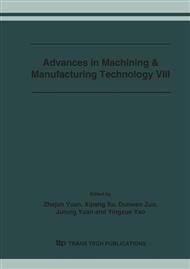p.617
p.623
p.628
p.632
p.637
p.641
p.646
p.651
p.656
Erosion Wear and Design Model of Functionally Gradient Ceramic AJM Nozzle
Abstract:
The stress states of the ceramic nozzle in abrasive jet machining (AJM) process are analyzed. Results shown that the maximum stress appears in entrance area of the nozzle and minimum stress in middle area, while the stress of exit area was lower than entrance area and higher than middle area. It can interprets why the entrance and exit area of the nozzle were worn badly. The idea of functionally gradient material (FGM) theory was used to design of ceramic nozzle. The purpose was to reduce the stresses at the entrance and exit area of the nozzle during AJM processes. The physical, composition distribution, and property parameter models of the FGM nozzle were established.
Info:
Periodical:
Pages:
637-640
Citation:
Online since:
July 2006
Authors:
Price:
Сopyright:
© 2006 Trans Tech Publications Ltd. All Rights Reserved
Share:
Citation:


